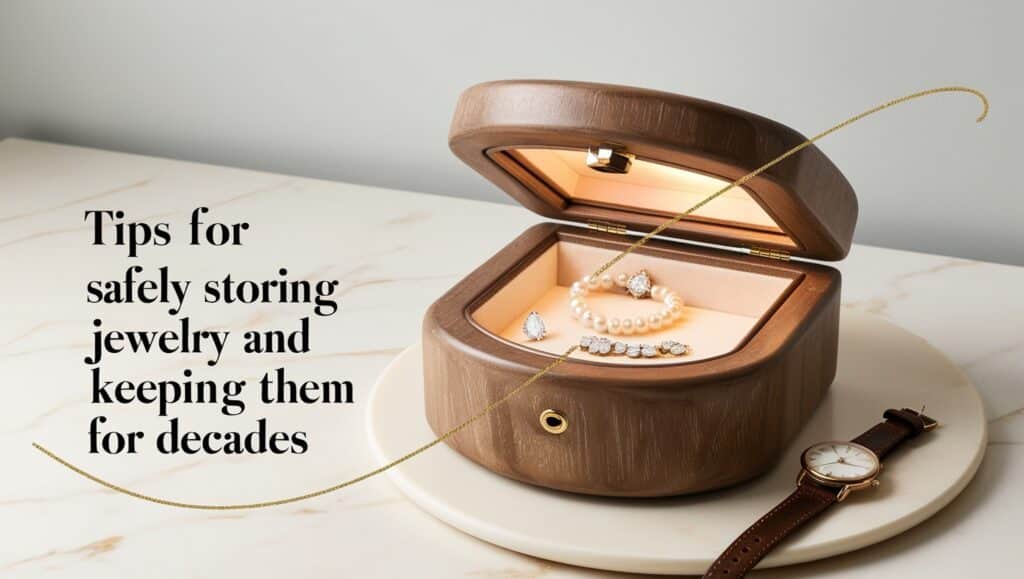Pearls, with their natural elegance and timeless beauty, are one of the most cherished gems in the world. Unlike other gemstones, pearls are organic, formed inside mollusks, making them more delicate. Due to their unique composition, they require special care and storage. If properly cared for, pearl jewelry can retain its luster and value for generations.
In this guide, we’ll explore the best tips for safely storing pearl jewelry to ensure it remains as radiant as the day you acquired it.
Why Pearl Jewelry Needs Special Care and Storage
Pearls are unlike any other gemstones—they are formed from layers of nacre, a combination of calcium carbonate and conchiolin. This gives pearls their signature luster but also makes them highly sensitive to their surroundings. Factors like humidity, temperature, chemicals, and friction can easily damage pearls.
Pearls are porous and soft, measuring only 2.5 to 4.5 on the Mohs hardness scale. As a result, they are more prone to scratches and damage from harsh chemicals. This is why careful storage is vital. If stored incorrectly, pearls can lose their luster, discolor, or even crack over time.
Key Vulnerabilities of Pearls:
- Susceptible to scratches from harder gemstones (diamonds, sapphires).
- Can deteriorate or discolor when exposed to chemicals such as perfumes or cleaning agents.
- Sensitive to humidity and dryness; they require a balanced environment to retain moisture.
You might also like The ultimate Pearl Guide
Best Storage Practices to Preserve Pearl Jewelry
Proper storage starts with understanding the unique needs of pearls. Let’s delve into specific techniques that can help keep your pearls safe and lustrous for years to come.
Key Factors to Consider for Pearl Storage
Moisture Levels
Pearls naturally absorb moisture from the air, which keeps them hydrated and lustrous. However, too much or too little moisture can lead to damage. Extremely dry environments can cause pearls to become brittle, while overly humid conditions may lead to discoloration.
Ideal Storage Conditions:
- Maintain humidity levels between 40-50%.
- Avoid storing pearls in extremely dry or air-conditioned environments for long periods.
Temperature Control
Pearls should be stored in a cool, stable environment. Avoid exposing them to extreme temperatures, which can cause expansion or contraction of the nacre layers.
Tip: Keep your pearls in a temperature-controlled room, away from direct heat sources like sunlight or radiators.
Explore Pearl Formation: Unveiling the secrets of natural vs cultured gems
Light Exposure
Prolonged exposure to direct sunlight can fade pearls, causing them to lose their signature iridescence. UV rays can break down the organic compounds in pearls, making them dull and lackluster.
Storage Tip: Always store pearls in a dark or dimly lit place, such as a drawer or a closed jewelry box.
Best Practices for Storing Pearl Jewelry
Using tips for safely storing your jewelry, here’s a breakdown of practices tailored to pearl storage.
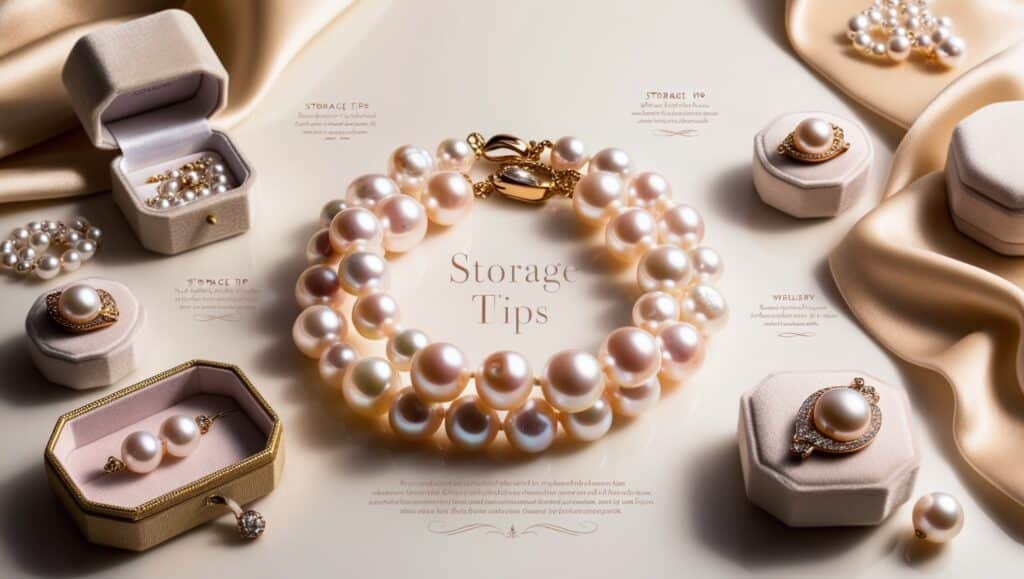
Clean Pearls Before Storage
It’s essential to clean your pearls before putting them away. After each wear, wipe them gently with a soft cloth to remove oils, sweat, and cosmetics. Pearls absorb body oils and products that can tarnish their appearance over time.
Steps to Clean Pearls:
- Use a soft, lint-free cloth to wipe each pearl.
- If needed, lightly dampen the cloth with warm, soapy water (use mild soap).
- Gently clean each pearl, avoiding pulling on the strand.
- Let them dry completely before storing.
Avoid: Using ultrasonic or steam cleaners, as they can damage the delicate nacre.
Store Pearls Separately to Avoid Scratches
One of the most common mistakes people make is storing pearls with other jewelry. Harder gemstones like diamonds or even metal settings can scratch pearls due to their low hardness.
Pearl Storage Tip:
- Store each piece of pearl jewelry in its own soft cloth pouch or box.
- Never let pearls rub against other materials that may scratch their surface.
Must read What does a pearl ring symbolize?
Use Soft Cloth or Silk Bags for Protection
For optimal protection, store pearls in soft cloth pouches, silk bags, or velvet-lined jewelry boxes. These materials provide a gentle cushion and prevent the pearls from being damaged by harder surfaces.
Best Materials for Storing Pearls:
- Silk pouches
- Velvet-lined compartments
- Soft cotton wraps
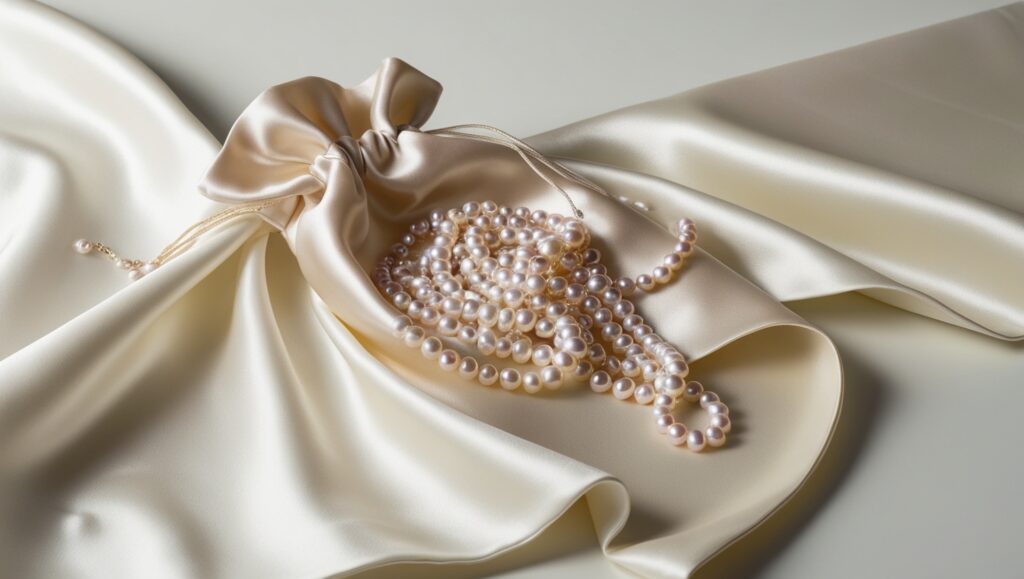
Original Boxes for Best Storage
If you have the original packaging from when you purchased your pearl jewelry, this is often the best place to store them. Manufacturers design these boxes to ensure the jewelry is kept safe from environmental damage.
Tip: The original box is typically padded, providing extra protection and keeping the jewelry from moving around.
Flat vs. Hanging Storage
How you store pearl necklaces or bracelets can impact their longevity. Some prefer to hang pearl strands, while others choose flat storage. Each has its pros and cons.
- Flat Storage: Laying pearl strands flat helps avoid unnecessary stretching or tension on the silk or nylon thread holding the pearls together.
- Hanging Storage: Hanging can be useful for short-term storage, but prolonged hanging may stretch the string, weakening the structure over time.
Pro Tip: Store pearls flat if you won’t be wearing them often to avoid loosening the string over time.
Also read Necklace length guide: crafting a perfect look for any occasion
Long-Term Care Tips to Maintain Pearl Luster
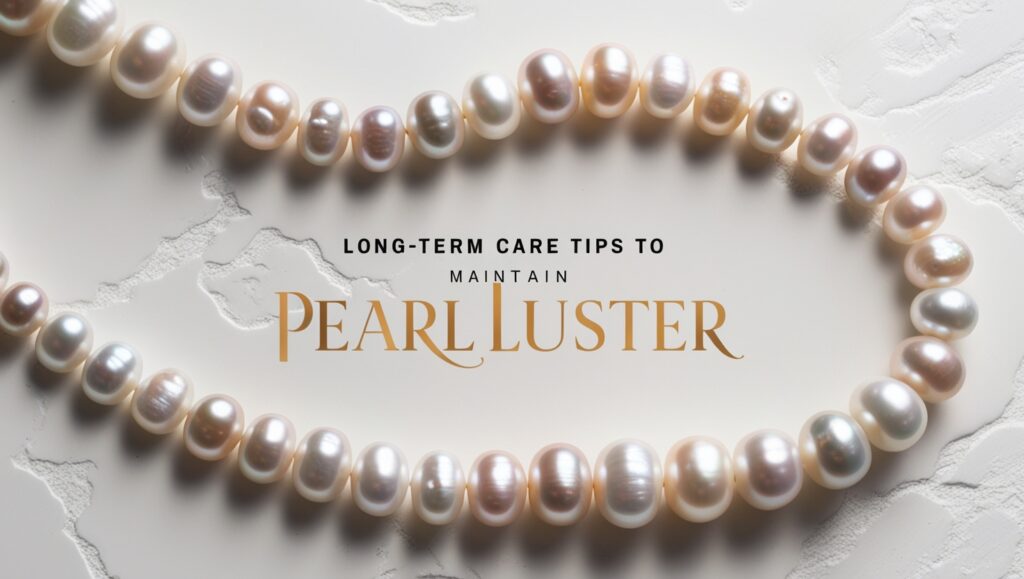
To ensure your pearls maintain their beauty for decades, follow these tips for safely storing your jewelry:
Wear Pearls Regularly
Unlike other gemstones, pearls benefit from being worn. Wearing pearls helps them maintain their moisture, as they absorb natural oils from your skin, which keep them hydrated and shiny.
Tip: Try to wear your pearls at least once a month to prevent them from drying out.
Regular Restringing
Pearl necklaces and bracelets should be restrung every few years, especially if worn frequently. Over time, the silk thread may weaken, loosen, or even fray.
Signs Your Pearls Need Restringing:
- Visible gaps between the pearls.
- The thread appears discolored or worn out.
- The necklace feels loose when worn.
Recommendation: Have pearls professionally restrung every 2-3 years if worn frequently, or every 5 years if worn occasionally.
Avoid Chemical Exposure
Pearls are extremely vulnerable to chemicals, which can erode their surface. This includes cosmetics, perfumes, hairspray, and even sweat. When wearing pearls, always follow the “last on, first off” rule.
Avoid:
- Spraying perfume or hairspray directly on your pearls.
- Wearing pearls in the shower, pool, or hot tub.
- Using household cleaning products near pearls.
You will like Diamonds vs Pearls: which one is truly more valuable?
Regular Inspections
Inspect your pearl jewelry regularly for signs of wear, damage, or loose stringing. If you notice scratches, cracks, or loose knots, it’s time to visit a jeweler for professional care.
Checklist for Pearl Inspection:
- Look for chips, cracks, or dull spots on the pearls.
- Check the string for fraying or discoloration.
- Ensure that clasps and fittings are secure and intact.
Storing Pearls for Travel
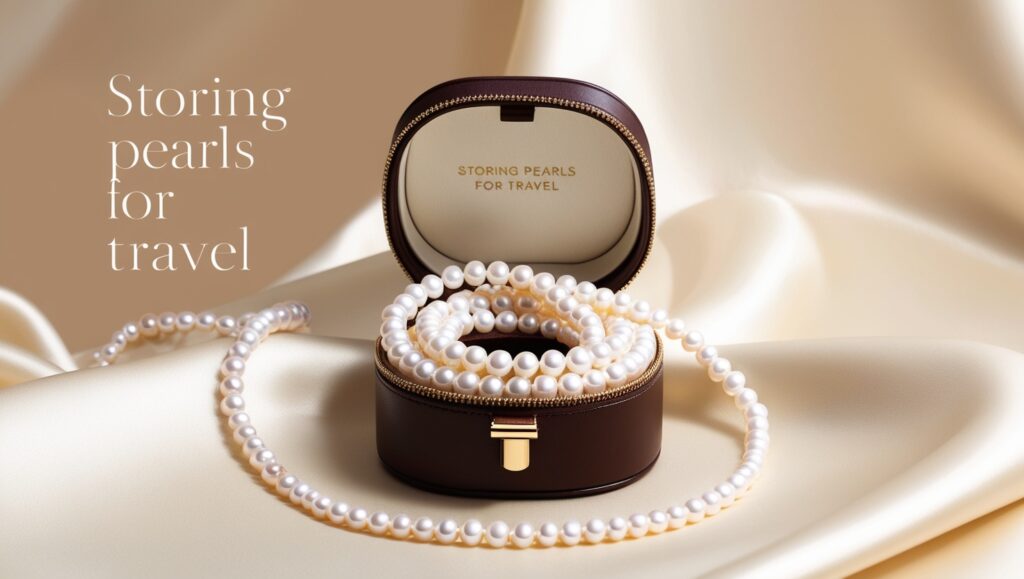
When traveling, it’s essential to store pearls safely to avoid damage from movement or external conditions. Compact, travel-friendly storage solutions will ensure your pearls arrive in perfect condition.
Compact Storage Ideas for Traveling
Traveling with pearl jewelry requires extra care, as they can easily become scratched or tangled. Opt for hard-sided jewelry cases with soft interiors to keep each piece separated and protected.Tips for safely storing your jewelry while traveling can help pearls remain in pristine condition.
Travel Storage Tips:
- Use individual cloth pouches for each piece.
- Choose a small, compartmentalized jewelry case with a soft lining.
- Avoid overpacking, which can lead to jewelry being crushed or damaged.
Avoid Prolonged Exposure to Heat or Dry Air While Traveling
When flying, dry cabin air can dehydrate pearls, while hotel safes might expose them to extreme dryness or temperature fluctuations.
Travel Tip: If possible, carry pearls in your handbag or keep them in a cool, stable environment. Once you arrive at your destination, clean them lightly and recondition with gentle oils if necessary.
Case Study: How Improper Storage Can Damage Pearls
Let’s explore a real-life example of improper pearl storage and its consequences. A woman inherited her grandmother’s pearl necklace, but over the years, she left it in a dry, heated room. After a decade, she noticed the pearls had become dull and brittle, with visible cracks in some beads. The silk string had also frayed, leading to loose knots.
Lessons Learned:
- Storage Environment: The room was too dry, causing the pearls to dehydrate.
- Lack of Wear: She didn’t wear the pearls regularly, so they lost their natural moisture.
- Improper Cleaning: The necklace hadn’t been cleaned after wear, leaving body oils and dust to accumulate.
This case highlights the importance of controlled storage and regular maintenance to avoid irreversible damage.
Conclusion
By following these tips for safely storing your jewelry, you’ll ensure that your pearls retain their luster and beauty for generations. By following these tips—cleaning pearls before storing, using soft bags, avoiding chemical exposure, and regularly inspecting and restringing—you’ll safeguard your investment for generations to come.
With the right care, pearls can remain an elegant symbol of beauty and tradition, passed down through your family with their stunning luster intact.
Feel free to share your experience with caring for pearls or leave a comment below!

Astro Sari is a seasoned blogger with a deep passion for pearls and oceanic gems. With years of experience in the field, he brings insightful knowledge and engaging content to Pearl Mystique. His expertise helps readers explore the beauty, history, and significance of pearls in a captivating way.

